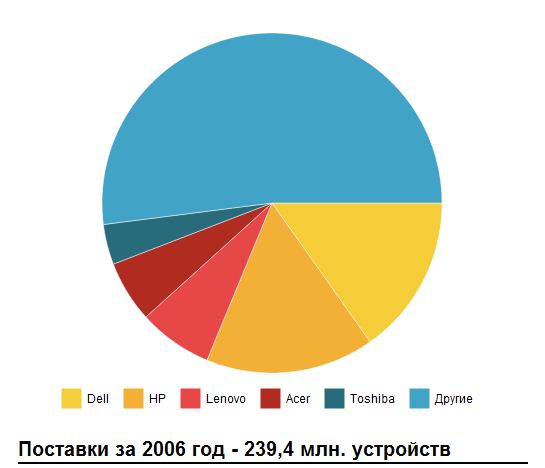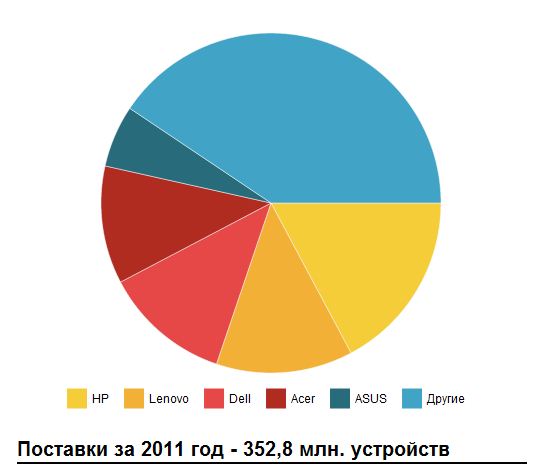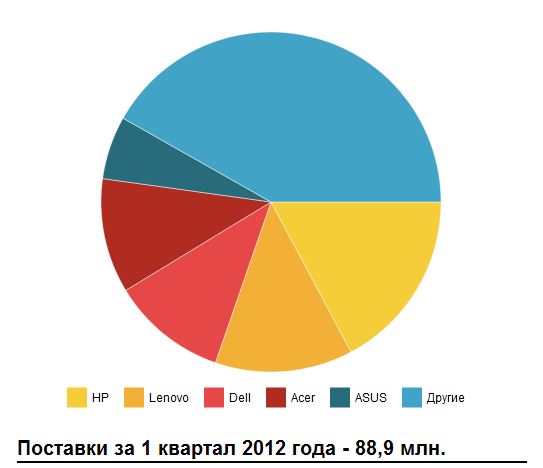We save on matches, Or ...?

I think everyone came across himself or saw from afar, what a huge amount of pre-installed software can be found on a modern laptop after the first power up. However, among the programs for installing drivers, for managing hot keys, or for entering the OS using a webcam and face recognition, I was interested in having only one small utility, the Super Hybrid Engine (SHE). Why did her presence seem important to me?
')
Let's see how many desktops and laptops are produced and sold every year.

I will not overflow this post with exact figures, I will only clarify that until 2000 this statistics included only PC X86 shipments, and later desktop PCs with laptops, including netbooks, but excluding tablet PCs (both on iOS and Android) .
The first illustration shows electricity consumption worldwide in 2008 (data became available only in April of this year, alas, more recent information on energy consumption could not be found). About 30% of all electricity consumption falls to the housing and utilities sector, including electricity for the population. It is difficult to deny that in our time the computer and / or laptop have taken a firm place in the house as an additional item of expenditure on electricity.
Let's see how the PC and laptop manufacturers market looked in 2006.

As you can see, almost half of the devices were produced by five major manufacturers. The situation changed in 2011 - now five manufacturers occupy more than 50% of the market.

ASUS company confidently entered the top five: in 2011, about 20 million devices - laptops, netbooks of the Eee series and PC. Most of them received pre-installed software - Super Hybrid Engine.

In the first quarter of 2012, ASUS produced approximately 5 million units, and in the second quarter, approximately 6 million.

Thus, even if you do not take into account all ( ! ) ASUS devices manufactured before 2011, and assume that SHE is installed on 75% of ASUS devices, then approximately 23 million devices are equipped with Super Hybrid Engine technology.
On the ASUS website we can find a short description of SHE:
“The Super Hybrid Engine (SHE) technology can significantly improve energy efficiency and provide increased laptop battery life for user convenience. SHE technology offers the user several modes of tuning performance and power consumption, which correspond to different scenarios of using a laptop. In addition, the SHE technology makes it possible to increase system performance with heavy CPU usage, and thus meet the requirements of resource-intensive tasks. "
This effect is achieved by reducing / increasing the frequency of the processor, turning off discrete graphics, and other means. Ideally, energy savings can reach a fantastic 53%. As the tests show, we are talking about saving 13-35%, in conditions close to real, depending on the configuration. Suppose that energy savings will be 15% (given that we are considering the entire line of ASUS products for 2011–2012).
So, 23 million ASUS devices per month consume 276,000,000 kWh.
We presume that the laptop consumes 50 watts, and it works 8 hours a day (this figure may be lower for netbooks and much higher for top gaming laptops and PCs, take it as a possible assumption). In this case, the energy savings per month will be 41,400,000 kWh. According to the tariffs of Moscow, this is approximately 1 billion 321 thousand rubles. annual savings are, for example, 1.85% of the annual production of the largest Sayano-Shushenskaya HPP.
What do these approximate calculations tell us? The fact that any company among the top five manufacturers of PCs and laptops should adopt this useful experience. If we imagine, without assumptions "down", that each of the approximately 1 billion ( ! ) Devices currently working will have its own Super Hybrid Engine, then the savings of even 15% per year are more than all the electricity that all hydro power plants in Russia produce taken. Not to mention the pleasant bonuses - a slightly smaller energy bill for the end user, longer laptop / netbook battery life and pleasant emotions from participating in saving energy worldwide.
Charts and graphs were constructed according to press releases of research company Gartner, Inc. for 2006-2012, data on energy consumption in 2008 provided by IEA / OECD
Source: https://habr.com/ru/post/148980/
All Articles